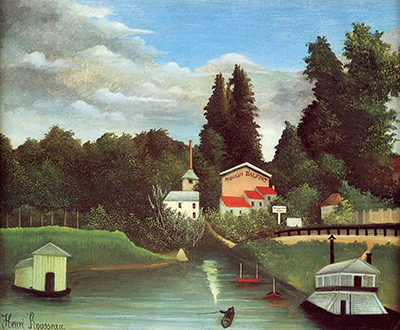Painted in 1895, The Moulin D'Alfort by Henri Rosseau is an oil on canvas painting with a height of 37.8 cm and a width of 45.5 cm. In the painting, there is an image of an institution/factory close to the banks of a river/lake.
The buildings are surrounded by thick vegetation, and a canal runs from the river to the institution/factory. There are also boats on the river and two floating buildings, one on the right side of the painting and the other on the left. The buildings and the river are placed at the centre of the painting, and the vegetation takes the larger part. One can also see the words "MOULIN D'ALFORT" on the wall of one of the buildings. The only sign of life is a person on a boat, but their image is not clear. Henri Rousseau's signature is also clearly visible at the bottom left of the painting.
Style Used
Since Rousseau was self-taught, his art did not fit in any category, thus considered primitive. Moreover, his artwork lacked correct proportions, plus he fond of using sharp and unnatural colours. All these features gave his work a sense of eccentricity and mystery. Additionally, Rousseau had an individualised approach to painting, which involved a careful blending of brushstrokes to produce a smooth surface. The controlled brushstrokes also made objects in his paintings appear outlined. His work is also comparable to Surrealism due to its heavy dependence on stiff posture and flattened perspective.
What Inspired Rousseau into Painting
Though Rousseau loved painting, he grew up in a modest family that would not afford to take him to art school. He dreamed of becoming a famous academic painter, but he became a full-time artist at the age of forty-nine, after retiring from his job as a tax collector in Paris. Though he never went out of Paris, Rousseau paintings were made from imagination and inspiration drawn from academic sculptures, trips to the Paris zoo, tabloid illustrations and postcards.
Artists Inspired by Rousseau’s Artworks
Though Rousseau's paintings were considered primitive due to their simplicity, he is regarded as a typical example of a modern naïve artist. However, some artists, like Pablo Picasso and Robert Delaunay, saw his work as a representation of directness and sincerity, and they were inspired to do the same in their work. For example, Picasso bought a Rousseau painting that was being sold on the streets as a canvas for re-use after he recognised his genius. The poet Guillaume Apollinaire also loved Rousseau's art style and became his principal supporter.
Location of The Artwork
The painting's current location is the Pola Museum of Arts in Hakone, Japan.




